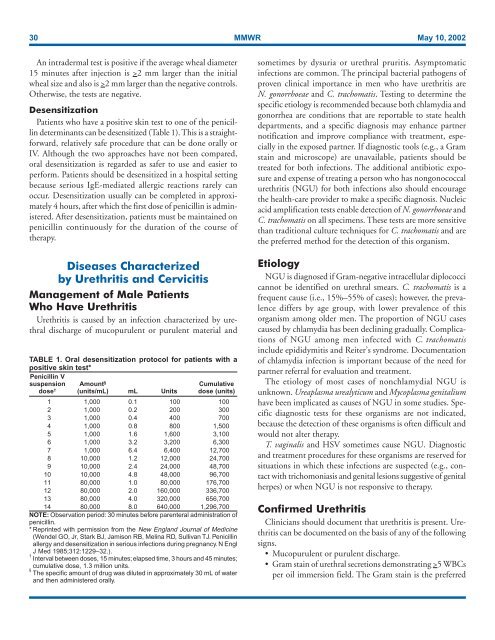Create successful ePaper yourself
Turn your PDF publications into a flip-book with our unique Google optimized e-Paper software.
30 MMWR May 10, 2002<br />
An intradermal test is positive if the average wheal diameter<br />
15 minutes after injection is >2 mm larger than the initial<br />
wheal size and also is >2 mm larger than the negative controls.<br />
Otherwise, the tests are negative.<br />
Desensitization<br />
Patients who have a positive skin test to one of the penicillin<br />
determinants can be desensitized (Table 1). This is a straightforward,<br />
relatively safe procedure that can be done orally or<br />
IV. Although the two approaches have not been compared,<br />
oral desensitization is regarded as safer to use and easier to<br />
perform. Patients should be desensitized in a hospital setting<br />
because serious IgE-mediated allergic reactions rarely can<br />
occur. Desensitization usually can be completed in approximately<br />
4 hours, after which the first dose of penicillin is administered.<br />
After desensitization, patients must be maintained on<br />
penicillin continuously for the duration of the course of<br />
therapy.<br />
Diseases Characterized<br />
by Urethritis and Cervicitis<br />
Management of Male Patients<br />
Who Have Urethritis<br />
Urethritis is caused by an infection characterized by urethral<br />
discharge of mucopurulent or purulent material and<br />
TABLE 1. Oral desensitization protocol for patients with a<br />
positive skin test*<br />
Penicillin V<br />
suspension Amount § Cumulative<br />
dose † (units/mL) mL Units dose (units)<br />
1 1,000 0.1 100 100<br />
2 1,000 0.2 200 300<br />
3 1,000 0.4 400 700<br />
4 1,000 0.8 800 1,500<br />
5 1,000 1.6 1,600 3,100<br />
6 1,000 3.2 3,200 6,300<br />
7 1,000 6.4 6,400 12,700<br />
8 10,000 1.2 12,000 24,700<br />
9 10,000 2.4 24,000 48,700<br />
10 10,000 4.8 48,000 96,700<br />
11 80,000 1.0 80,000 176,700<br />
12 80,000 2.0 160,000 336,700<br />
13 80,000 4.0 320,000 656,700<br />
14 80,000 8.0 640,000 1,296,700<br />
NOTE: Observation period: 30 minutes before parenteral administration of<br />
penicillin.<br />
* Reprinted with permission from the New England Journal of Medicine<br />
(Wendel GO, Jr, Stark BJ, Jamison RB, Melina RD, Sullivan TJ. Penicillin<br />
allergy and desensitization in serious infections during pregnancy. N Engl<br />
J Med 1985;312:1229–32.).<br />
†<br />
Interval between doses, 15 minutes; elapsed time, 3 hours and 45 minutes;<br />
cumulative dose, 1.3 million units.<br />
§<br />
The specific amount of drug was diluted in approximately 30 mL of water<br />
and then administered orally.<br />
sometimes by dysuria or urethral pruritis. Asymptomatic<br />
infections are common. The principal bacterial pathogens of<br />
proven clinical importance in men who have urethritis are<br />
N. gonorrhoeae and C. trachomatis. Testing to determine the<br />
specific etiology is recommended because both chlamydia and<br />
gonorrhea are conditions that are reportable to state health<br />
departments, and a specific diagnosis may enhance partner<br />
notification and improve compliance with treatment, especially<br />
in the exposed partner. If diagnostic tools (e.g., a Gram<br />
stain and microscope) are unavailable, patients should be<br />
treated for both infections. The additional antibiotic exposure<br />
and expense of treating a person who has nongonococcal<br />
urethritis (NGU) for both infections also should encourage<br />
the health-care provider to make a specific diagnosis. Nucleic<br />
acid amplification tests enable detection of N. gonorrhoeae and<br />
C. trachomatis on all specimens. These tests are more sensitive<br />
than traditional culture techniques for C. trachomatis and are<br />
the preferred method for the detection of this organism.<br />
Etiology<br />
NGU is diagnosed if Gram-negative intracellular diplococci<br />
cannot be identified on urethral smears. C. trachomatis is a<br />
frequent cause (i.e., 15%–55% of cases); however, the prevalence<br />
differs by age group, with lower prevalence of this<br />
organism among older men. The proportion of NGU cases<br />
caused by chlamydia has been declining gradually. Complications<br />
of NGU among men infected with C. trachomatis<br />
include epididymitis and Reiter’s syndrome. Documentation<br />
of chlamydia infection is important because of the need for<br />
partner referral for evaluation and treatment.<br />
The etiology of most cases of nonchlamydial NGU is<br />
unknown. Ureaplasma urealyticum and Mycoplasma genitalium<br />
have been implicated as causes of NGU in some studies. Specific<br />
diagnostic tests for these organisms are not indicated,<br />
because the detection of these organisms is often difficult and<br />
would not alter therapy.<br />
T. vaginalis and HSV sometimes cause NGU. Diagnostic<br />
and treatment procedures for these organisms are reserved for<br />
situations in which these infections are suspected (e.g., contact<br />
with trichomoniasis and genital lesions suggestive of genital<br />
herpes) or when NGU is not responsive to therapy.<br />
Confirmed Urethritis<br />
Clinicians should document that urethritis is present. Urethritis<br />
can be documented on the basis of any of the following<br />
signs.<br />
Mucopurulent or purulent discharge.<br />
Gram stain of urethral secretions demonstrating >5 WBCs<br />
per oil immersion field. The Gram stain is the preferred


